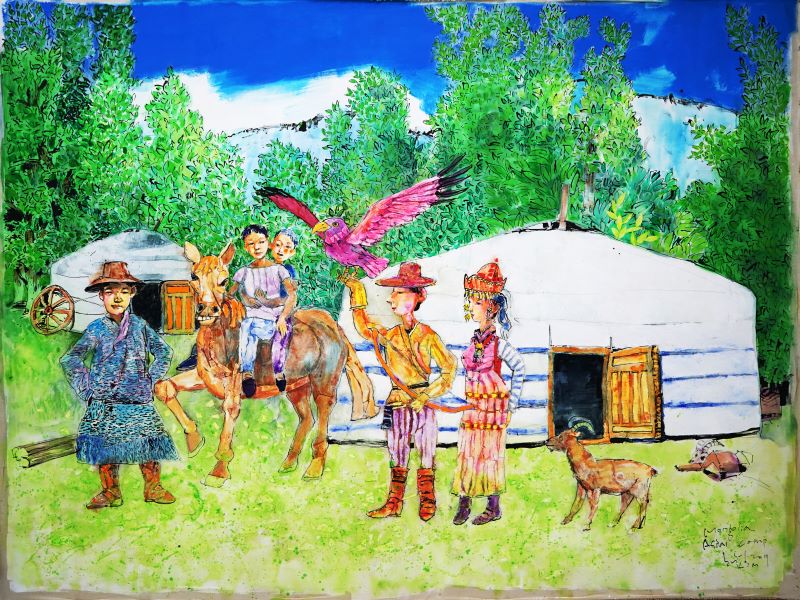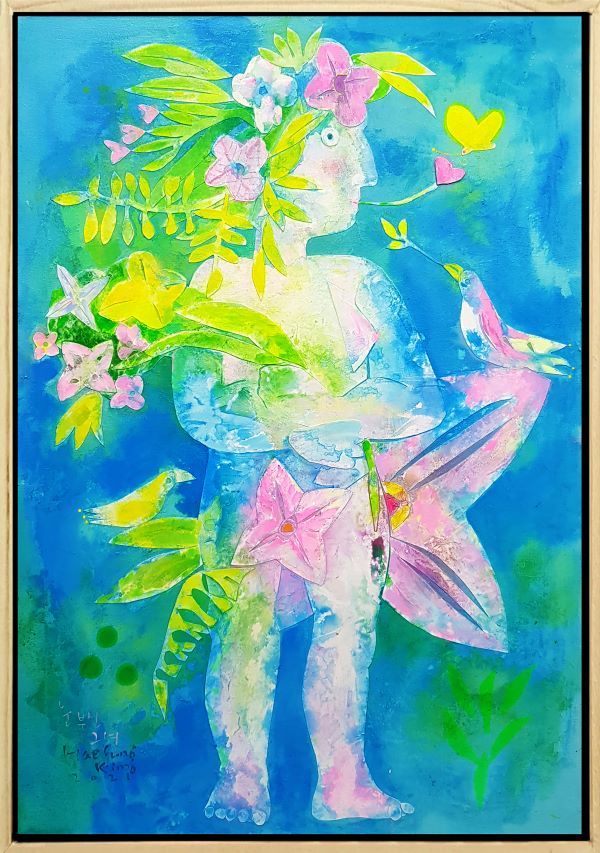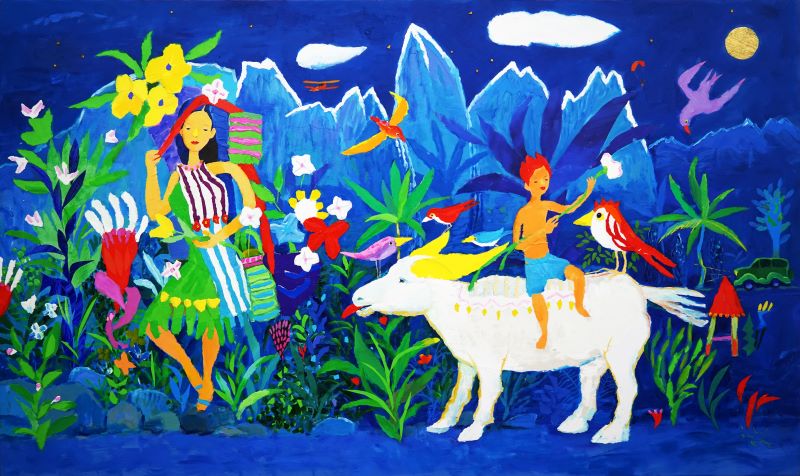In Search of True Happiness in Life
Travel Sketching by Artist Kim Hae-sung
By Kang “Jennis” Hyunsuk
Kim Hae-sung was born and raised in Gwangju and is known as a watercolor artist. Whenever I go to see his art exhibitions, I cannot help loving his fantastic paintings. For this month’s column, I interviewed Artist Kim at his studio in downtown Gwangju.
Jennis: Thank you for this interview for People in the Arts for the Gwangju News. Coming up the stairs to your studio was like entering an unknown jungle. The works depicting happy-faced animals such as water buffalo, mules, and birds in the green of nature are marvelous. I wonder if you have liked painting since your childhood.
Kim Hae-sung: This studio is where I used to run around when I was a kid. I grew up in this downtown area, where my parents operated stores, and I went to Jungang Elementary School on Art Street. I have liked drawing since I was young. I drew pictures on my friends’ arms with a felt pen, and I received marbles or picture card stickers for my drawings. They even waited in line to get my drawings during school recesses. I did not study painting until I went to high school, but I have always been drawing and painting.
Jennis: I heard that you graduated from the College of Fine Arts at Chosun University. What were your early works like? I wonder what kind of changes your works have gone through.
Kim Hae-sung: Since I went through Gwangju’s May 18 Uprising when I was a sophomore in college, I think it was a natural process to try to express the issues I experienced as a young painter. But painting that deals with heavy topics did not seem to be a good fit for me. So, I started to paint stories about the environment that make us beings.

Jennis: You have been to Beijing as part of the 1st Residency Team of the Gwangju Museum of Art. How was your work there?
Kim Hae-sung: China has a lot of peoples living together. There are more than 50 officially recognized ethnic minorities. I painted the traditional costumes that the different ethnic groups wear on their own festival days in 120 works. I put the 120 small paintings together to create one large artwork. Its message was “When Small Diversities Meet, One Big Beauty Is Created.”
Jennis: You have made a lot of travel sketches – what kind of opportunity did you have?
Kim Hae-sung: My first sketching trip started in 1994. I was a member of the serialization project team for the Mudeung Ilbo newspaper in Gwangju. We took a train from Khabarovsk, Russia, to report on what we saw on our way across Russia to Europe for the newspaper.
Jennis: I wonder what the cross-continent Russian train trip was like 30 years ago, back in 1994.
Kim Hae-sung: I started my journey across Siberia, imagining the vastness of nature in Russia through the works of great Russian artists like Tolstoy and Tchaikovsky. But it is not easy to stay in a narrow space for many days. The trees outside the train window seemed endless. After passing a hazy horizon, the swamps, and misty rivers, the trees sparkled under the blue sky. I was inspired by the scenes passing by outside the window. There were hard and painful moments on the journey, too. But I think that how one copes with them is up to each person.

Jennis: Have you been doing travel sketches consistently since then? Which countries have you traveled to?
Kim Hae-sung: I usually travel to remote areas in Central Asia, South Asia, and Southeast Asia, such as Mongolia, Nepal, the Himalayas, and India. I once went to Yunnan in China to find Shangri-La. And in the Mongolian desert, I slept in a sleeping bag on the sand. I was surprised when I opened the zipper of my sleeping bag in the middle of the night and opened my eyes. The sky was right in front of me, and I felt like the stars were pouring into my face, causing me to quickly turn my head to the side.
Jennis: You have been to many countries – where and what was the most impressive moment?
Kim Hae-sung: The most memorable place is Ladakh in northernmost India – an area that has hosted a self-sufficient community with minimal support in a barren environment with a winter that lasted for more than eight months. Living in a rich, modern city, I feel the high-rises making longer and darker shadows behind them. And I think the gap between the rich and the poor is getting wider in this modern society. But the people of Ladakh, who we think of as not living well, were really living quite humanly. It was a place of helping each other, and I felt like I was seeing our old days. As in the book Ancient Futures, for those of us these days who think that only owning a lot is happiness, Ladakh was a place that made us think about what true happiness is.

Jennis: Do you go on these journeys alone?
Kim Hae-sung: There is an organization called the International Cooperation Association OGC (국제협력단 OGC) in Gwangju. It is an organization that has built a Gwangju Clinic in Nepal and provides medical services. We have been traveling together once a year. The trips paused during the Covid-19 pandemic, but we plan to travel again next summer. Art lovers and artists travel together. If the art lovers support the travel expenses of the artists, the artists return the gesture with sketches from their trips. It is a win-win arrangement.
Jennis: When you go on a sketching trip, do you draw on the spot or after traveling?
Kim Hae-sung: Most of what I do is draw sketches on the spot. But in the field, I draw with light and simple tools, so sometimes when I want to express a concept with various materials, I come back and work in the studio. I sometimes use indigenous handmade cloth that I bring back from the area I visited for my paintings.
Jennis: Your work features flowers, trees, and animals. You especially draw a lot of birds in your paintings. What has led you in this direction?
Kim Hae-sung: Birds fly freely in the sky. They have to have a light body for this freedom that transcends the earth. If they are greedy and get bigger, they will not be able to fly freely. I learn from the birds. From long ago, humans have worshiped birds, and so do I.
Jennis: As an artist, what do you think you gain most from your sketching trips?
Kim Hae-sung: There are moments when I realize the reason for my traveling through the process. Not all things in this world go as expected. I am just going to do my best at every moment and, if possible, think happy thoughts and live happily.
Jennis: What are your future painting plans?
Kim Hae-sung: My “Ink Flower” Exhibition is at the ACC Design Hotel Gallery on Geumnam-ro and runs through October 21. In it, I express my favorite theme, flowers, using only the most basic materials for painting.
Jennis: Congratulations on your exhibition and thank you for this delightful and detailed interview.
Kim Hae-sung’s Profile
- College of Fine Arts, Chosun University: BA, MFA
- Individual Exhibitions: 29; Group Exhibitions: 650
- Art Studio: White Space, 23-3 Hwanggeum-dong, Dong-gu, Gwangju
- Email: star9993@naver.com
Select Exhibitions
- Koln Art Fair (Cologne, Germany)
- Art Beijing (Beijing, China)
- All About Korea (White Box, Munich, Germany)
- Korean Contemporary (Schultz Contemporary, Berlin, Germany)
- Something Different – 春 Spring (Red Art Gallery, Beijing)
- Korea-China Art Exchange Exhibition (Dashanzi798, Beijing)
- The Winners of the Joong-Ang Arts Contest (Hoam Art Museum)
- The Second Gwangju Biennale Special Exhibition
- Today’s Artists (Kumho Art Museum)
The Interviewer
Jennis Kang is a lifelong resident of Gwangju. She has been doing oil painting for almost a decade, and she has learned that there are a lot of fabulous artists in this City of Art. As a freelance interpreter and translator, her desire is to introduce these wonderful artists to the world. Instagram: @jenniskang





